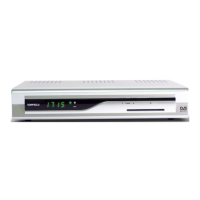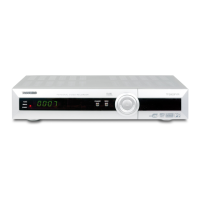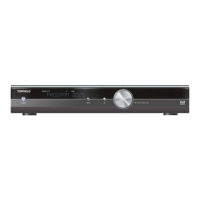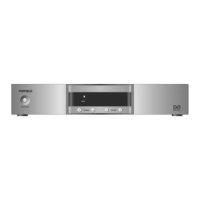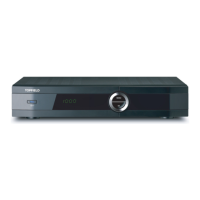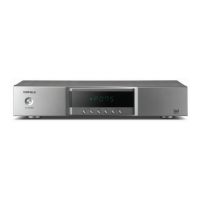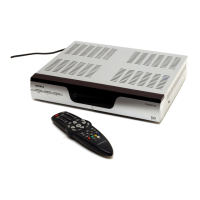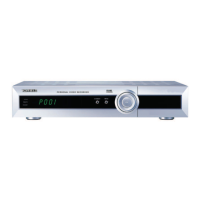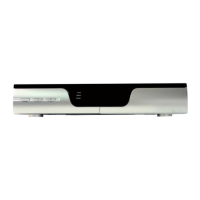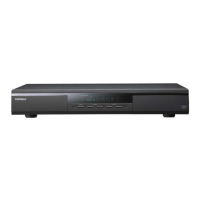
Do you have a question about the Topfield TF 6000 PVR and is the answer not in the manual?
| PVR Function | Yes |
|---|---|
| Recording | Yes |
| USB | Yes |
| Video Formats | MPEG-2 |
| EPG | Yes |
| Audio Formats | MPEG |
| Outputs | HDMI, SCART |
| Video Output | Composite |
| Audio Output | Stereo |
| Common Interface | Yes |
Lists the key features of the TF 6000 PVR digital receiver, including supported standards and storage capacity.
Explains how to operate the digital receiver using its remote control and front panel buttons.
Details the buttons and display on the front panel of the digital receiver and their functions.
Provides a comprehensive guide to all buttons on the remote control and their respective operations.
Explains the Common Interface feature for accessing scrambled broadcasts with a CAM module and subscription card.
Lists the items included in the package with the digital receiver.
Outlines essential safety guidelines for using the digital receiver, including power and environmental considerations.
Describes the various connectors available on the back panel of the digital receiver.
Provides instructions on how to connect the digital receiver to other devices.
Details the steps for connecting the satellite antenna to the receiver's LNB input.
Explains how to connect the receiver to a television using various video output options.
Guides on connecting the digital receiver to a VCR for outputting video signals.
Instructions on how to properly insert batteries into the remote control unit.
Allows users to set preferred languages for menus, audio tracks, and subtitle tracks.
Guides on configuring video and audio output settings for optimal performance with your TV.
Explains how to set the TV type standard for compatibility with PAL or NTSC broadcasts.
Details how to select the video output color model for different connection types.
Configures how the receiver interacts with a connected VCR, affecting video passthrough.
Provides options to set the aspect ratio (e.g., 16:9, 4:3) for wide-screen or normal televisions.
Allows selection of audio output modes such as Stereo or Mono.
Explains how to set the local time for accurate timer events and program guides.
Enables setting content ratings and PIN codes to restrict access to certain programs.
Allows customization of OSD transparency, info box display time, and position.
Instructions on how to enable and utilize the time shift functionality for pausing live TV.
Guides on configuring the MediaHighway electronic program guide for enhanced information.
Outlines the general process for searching satellite broadcasting services.
Details how to configure LNB settings for satellite reception, including LNB frequency and power.
Instructions for setting up DiSEqC 1.2 for motorized satellite antenna control.
Guides on using USALS (DiSEqC 1.3) for automatic satellite position calculation.
Explains the different methods for searching for satellite and transponder services.
Describes how to copy service lists between tuners to manage channel data.
Details the process for resetting the receiver to its original factory default settings.
How to adjust the audio volume and temporarily mute the sound output.
Guides on changing channels, navigating service lists, and selecting programs.
Instructions on creating, selecting, and watching services from your favorite lists.
How to display detailed information about the current program and upcoming broadcasts.
How to choose different audio language tracks or sound modes for programs.
Instructions for selecting available subtitle tracks for programs.
How to access and navigate teletext pages for additional program information.
How to view the EPG for scheduled programs, summaries, and broadcasting times.
Explains how to view different perspectives of a program provided simultaneously (multifeed).
Detailed instructions on how to pause, rewind, and fast-forward live TV using time shift.
Guides on how to watch two services simultaneously using the picture-in-picture feature.
How to rename, move, lock, or delete service entries in the channel list.
Instructions on creating and organizing custom favorite lists for channels.
Process for transferring receiver data, such as service and preference settings, via RS-232.
Using PC software (Vega) to edit satellite, transponder, and service lists.
How to add, delete, or modify satellite and transponder entries using PC software.
Using PC software to edit TV and radio service lists, including locking and renaming.
Managing favorite lists and groups for TV and radio services using PC software.
Overview of recording capabilities, including simultaneous recording and playback.
How to start recording the currently viewed program immediately.
Instructions for scheduling recordings at specific times or recurring intervals.
Using the EPG to set up recording timers for programs.
How to record a program while it is being time-shifted.
Guidance on recording pay TV programs, especially in descrambled form.
Managing recorded files, including playback, deletion, renaming, and sorting.
Instructions on how to play recorded programs and use playback controls.
How to watch recordings in slow motion.
How to watch recordings in fast forward or rewind motion.
How to mark specific points in a recording for easy navigation.
Options for playing back entire recordings or specific parts repeatedly.
How to play multiple recorded files continuously in sequence.
Information on playing back recorded pay service programs, including descrambling status.
How to cut out or save specific segments from recorded programs.
Instructions on how to copy entire or partial recordings to another file.
How to play MP3 audio files using the digital receiver.
Using the Altair program to transfer files between the receiver and a computer via USB.
Procedure for formatting the internal hard disk, which erases all data.
Guidance on router configuration, including DHCP settings and port forwarding for remote access.
How to access the receiver on the local network, including static IP address assignment.
Steps for accessing the receiver from outside the home network using port forwarding.
Setting up WLAN, IP configuration, and advanced network options for remote access.
How to access the receiver's web interface for file management and system information.
Instructions for connecting to the receiver's FTP server using a client program.
How to update the receiver's firmware wirelessly through the air.
Instructions for updating firmware using a USB connection and transfer utility.
How to update firmware from a computer using an RS-232 serial cable.
Process for transferring firmware from one digital receiver to another via RS-232.
